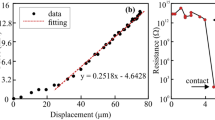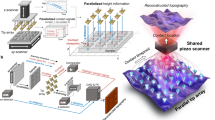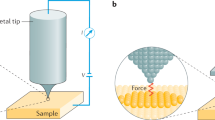Abstract
As the size of electronic devices continues to shrink, characterization methods capable of precisely probing localized properties become increasingly important. Scanning probe microscopy techniques can examine local phenomena, and conductive atomic force microscopy can, in particular, study local electromechanical properties. Such techniques have already played a valuable role in the development of nanoelectronics, but their capabilities remain relatively limited compared with the probe stations typically used to examine electronic devices. Here, we discuss the potential of conductive atomic force microscopy in nanoelectronics. We explore possible characterization strategies, enhanced electronics for the technique and improved multiprobe approaches. We also propose a multiprobe scanning probe microscopy system that combines different types of probes and could allow multiple nanofabrication and characterization experiments to be carried out simultaneously and under vacuum conditions.
This is a preview of subscription content, access via your institution
Access options
Access Nature and 54 other Nature Portfolio journals
Get Nature+, our best-value online-access subscription
$29.99 / 30 days
cancel any time
Subscribe to this journal
Receive 12 digital issues and online access to articles
$119.00 per year
only $9.92 per issue
Buy this article
- Purchase on Springer Link
- Instant access to full article PDF
Prices may be subject to local taxes which are calculated during checkout




Similar content being viewed by others
References
Moore, G. E. Progress in digital integrated electronics. In Technical Digest. IEEE Int. Electron Devices Meet. 11–13 (IEEE, 1975); https://doi.org/10.1109/N-SSC.2006.4804410
International Roadmap for Devices and Systems (IRDS, 2017); https://irds.ieee.org/roadmap-2017
Allport, P. P. et al. FOXFET biased microstrip detectors. Nucl. Instrum. Methods Phys. Res. A 310, 155–159 (1991).
Xiang, J. et al. Ge/Si nanowire heterostructures as high-performance field-effect transistors. Nature 441, 489–493 (2006).
Lanza, M. et al. Recommended methods to study resistive switching devices. Adv. Electron. Mater. 1, 1800143 (2018).
Murrell, M. P. et al. Spatially resolved electrical measurements of SiO2 gate oxides using atomic force microscopy. Appl. Phys. Lett. 62, 786–788 (1993).
Capella, B. & Dietler, G. Force–distance curves by atomic force microscopy. Surf. Sci. Rep. 34, 1–104 (1999).
Pan, C., Shi., Y., Hui, F., Grustan-Gutierrez, E. & Lanza, M. in Conductive Atomic Force Microscopy: Application in Nanomaterials (ed. Lanza, M.) Ch. 1 (Wiley-VCH, 2017).
Lewis, D., Ignatov, A., Krol, S., Dekhter, R. & Strinkovsky, A. in Conductive Atomic Force Microscopy: Application in Nanomaterials (ed. Lanza, M.) Ch. 13 (Wiley-VCH, 2017).
Lanza, M. et al. Electrical resolution during conductive AFM measurements under different environmental conditions and contact forces. Rev. Sci. Instrum. 81, 106110 (2010).
Iglesias, V., Jing, X. & Lanza, M. in Conductive Atomic Force Microscopy: Application in Nanomaterials (ed. Lanza, M.) Ch. 10 (Wiley-VCH, 2017).
Iglesias, V. et al. Correlation between the nanoscale electrical and morphological properties of crystallized hafnium oxide-based metal oxide semiconductor structures. Appl. Phys. Lett. 97, 262906 (2010).
Binnig, G. & Rohrer, H. Scanning tunneling microscopy. Surf. Sci. 126, 236–244 (1983).
Frammelsberger, W., Benstetter, G., Kiely, J. & Stamp, R. C-AFM-based thickness determination of thin and ultra-thin SiO2 films by use of different conductive-coated probe tips. Appl. Surf. Sci. 253, 3615–3626 (2007).
Pirrotta, O. Leakage current though the poly-crystalline HfO2: trap densities at the grains and grain boundaries. J. Appl. Phys. 114, 134503 (2013).
Lanza, M. et al. Trapped charge and stress induced leakage current (SILC) in tunnel SiO2 layers of de-processed MOS non-volatile memory devices observed at the nanoscale. Microelectron. Reliab. 49, 1188–1191 (2009).
Muensterman, R. et al. Correlation between growth kinetics and nanoscale resistive switching properties of SrTiO3 thin films. J. Appl. Phys. 108, 124504 (2010).
Kajewski, D. et al. Local conductivity of epitaxial Fe-doped SrTiO3 thin films. Phase Transit. 84, 5–6 (2011).
Gomez-Navarro, C. et al. Tuning the conductance of single-walled carbon nanotubes by ion irradiation in the Anderson localization regime. Nat. Mater. 4, 534–539 (2005).
Uppal, H. J. Breakdown and degradation of ultrathin Hf-based (HfO2)x(SiO2)1–x gate oxide films. J. Vac. Sci. Technol. B 27, 443–447 (2009).
Lanza, M. A review on resistive switching in high-k dielectrics: a nanoscale point of view using conductive atomic force microscope. Materials 7, 2155–2182 (2014).
Giannazzo, F., Sonde, S., Rimini, E. & Raineri, B. Lateral homogeneity of the electronic properties in pristine and ion-irradiated graphene probed by scanning capacitance spectroscopy. Nanoscale Res. Lett. 6, 109 (2011).
Wang, Z. L. & Song, J. H. Piezoelectric nanogenerators based on zinc oxide nanowire arrays. Science 312, 242–246 (2006).
Hung, S. C., Su, Y. K., Chang, S. J. & Chen, Y. H. Vertically aligned GaN nanotubes — fabrication and current image analysis. Microelectron. Eng. 83, 2441–2445 (2006).
Lv, Y., Cui, J., Jiang, Z. M. & Yang, X. J. Composition and conductance distributions of single GeSi quantum rings studied by conductive atomic force microscopy combined with selective chemical etching. Nanotechnology 24, 065702 (2013).
Shi, Y. et al. Electronic synapses made of layered two-dimensional materials. Nat. Electron. 1, 458–465 (2018).
Wen, Y. et al. Multilayer graphene-coated atomic force microscopy tips for molecular junctions. Adv. Mater. 24, 3482–3485 (2012).
Frederix, P. L. T. M. et al. Assessment of insulated conductive cantilevers for biology and electrochemistry. Nanotechnology 16, 997–1005 (2005).
Xiao, J. X. et al. Room temperature ferroelectricity of hybrid organic-inorganic perovskites with mixed iodine and bromine. J. Mater. Chem. A 6, 9665–9676 (2018).
Han, T. et al. Photo-electrochemical water splitting in silicon based photocathodes enhanced by plasmonic/catalytic nanostructures. Mater. Sci. Eng. B 225, 128–133 (2017).
Bhaskar, U. K. et al. A flexoelectric microelectromechanical system on silicon. Nat. Nanotechnol. 11, 263–266 (2016).
Pan, C. et al. Suppression of nanowire clustering in hybrid energy harvesters. J. Mater. Chem. C. 4, 3646–3653 (2014).
Song, X. et al. Enhanced piezoelectric effect at the edges of stepped molybdenum dissulfide nanosheets. Nanoscale 9, 6237–6245 (2017).
Ranjan, A. et al. Analysis of quantum conductance, read disturb and switching statistics in HfO2 RRAM using conductive AFM. Microelectron. Reliab. 64, 172–178 (2016).
Benstetter, G., Hofer, A., Liu, D., Frammelsberger, W. & Lanza, M. in Conductive Atomic Force Microscopy: Application in Nanomaterials (ed. Lanza, M.) Ch. 3 (Wiley-VCH, 2017).
Krause, O. in Conductive Atomic Force Microscopy: Application in Nanomaterials (ed. Lanza, M.) Ch. 2 (Wiley-VCH, 2017).
Khun, N. W. Scratch-induced wear behavior of aluminum alloy under dry and wet conditions. J. Mechatron. 3, 301–306 (2016).
Simultaneous Electrical and Mechanical Property Mapping at the Nanoscale with PeakForce TUNA Application Note 132 (Bruker, 2011); https://www.bruker.com/products/surface-and-dimensional-analysis/atomic-force-microscopes/modes/modes/nanoelectrical-modes/pf-tuna.html
Pacheco, L. & Martinez, N. F. in Conductive Atomic Force Microscopy: Application in Nanomaterials (ed. Lanza, M.) Ch. 12 (Wiley-VCH, 2017).
Shi, Y. et al. In situ demonstration of the link between mechanical strength and resistive switching in resistive random-access memories. Adv. Electron. Mater. 1, 1400058 (2015).
Kim, K. S. et al. Large-scale pattern growth of graphene films for stretchable transparent electrodes. Nature 457, 706–710 (2009).
Yao, J. et al. Highly transparent nonvolatile resistive memory devices from silicon oxide and graphene. Nat. Commun. 3, 1101 (2012).
Pan, C. et al. Coexistence of grain-boundaries-assisted bipolar and threshold resistive switching in multilayer hexagonal boron nitride. Adv. Funct. Mater. 27, 1604711 (2017).
Hui, F. et al. Graphene and related materials for resistive random access memories. Adv. Electron. Mater. 3, 1600195 (2017).
Miao, F. et al. Anatomy of a nanoscale conduction channel reveals the mechanism of a high-performance memristor. Adv. Mater. 23, 5633–5640 (2001).
SuperFlat AFM. Kleindiek Nanotechnik https://www.nanotechnik.com/sf-afm.html (2019).
Wen, C. et al. In situ observation of current generation in ZnO nanowire based nanogenerators using a CAFM integrated into an SEM. ACS Appl. Mater. Interfaces 11, 15183–15188 (2019).
Celano, U. Metrology and Physical Mechanisms in New Generation Ionic Devices (Springer Theses, Springer, 2016)
Garcia, R., Knoll, A. W. & Riedo, E. Advanced scanning probe lithography. Nat. Nanotechnol. 9, 577–587 (2014).
Liu, D., Benstetter, G. & Frammelsberger, W. The effect of the surface layer of tetrahedral amorphous carbon films on their tribological and electron emission properties investigated by atomic force microscopy. Appl. Phys. Lett. 82, 3898 (2003).
Celano, U. et al. Conductive-AFM tomography for 3D filament observation in resistive switching devices. In 2013 IEEE Int. Electron Devices Meet. 21.6.1–21.6.4 (IEEE, 2013); https://doi.org/10.1109/IEDM.2013.6724679
Chen, S. et al. On the limits of scalpel AFM for the three dimensional electrical characterization of nanomaterials. Adv. Funct. Mater. 28, 1802266 (2018).
Hammock, S. M. 3D c-AFM Imaging of Conductive Filaments in HfO 2 Resistive Switching Devices (Texas A&M University Libraries, 2017).
Buckwell, M., Montesi, L., Hudziak, S., Mehonic, A. & Kenyon, A. J. Conductance tomography of conductive filaments in intrinsic silicon-rich silica RRAM. Nanoscale 7, 18030–18035 (2015).
Luria, J. et al. Charge transport in CdTe solar cells revealed by conductive tomographic atomic force microscopy. Nat. Energy 1, 16150 (2016).
Porti, M., Aguilera, L., Blasco, X., Nafria, M. & Aymerich, X. Reliability of SiO2 and high-k gate insulators: a nanoscale study with conductive atomic force microscopy. Microelectron. Eng. 84, 501–505 (2007).
Ranjan, A. et al. CAFM based spectroscopy of stress-induced defects in HfO2 with experimental evidence of the clustering model and metastable vacancy defect state. In 2016 IEEE Int. Reliability Phys. Symp. 7A-4-1–7A-4-7 (IEEE, 2016); https://doi.org/10.1109/IRPS.2016.7574576
Jiang, L. et al. Dielectric breakdown in chemical vapor deposited hexagonal boron nitride. ACS Appl. Mater. Interfaces 9, 39758–39770 (2017).
Wu, Y. L., Lin, J. J., Chang, S. H. & Huang, C. Y. The degradation of thin silicon dioxide films subjected to pulse voltage stresses at nanoscale. ECS Trans. 28, 339–343 (2010).
Foissac, R., Blonkowski, S. & Kogelschatz, M. Nanoscale characterization of high-K/IL gate stack TDDB distributions after high-field prestress pulses. IEEE Trans. Device Mater. Reliab. 15, 298–307 (2015).
Lau, C. N., Stewart, D. R., Williams, S. & Bockrath, M. Direct observation of nanoscale switching centers in metal/molecule/ metal structures. Nano Lett. 4, 569–572 (2004).
Miao, F. et al. Anatomy of a nanoscale conduction channel reveals the mechanism of a high-performance memristor. Adv. Mater. 23, 5633–5640 (2011).
Park NX-Hivac: high vacuum atomic force microscope. Park Systems https://www.parksystems.com/index.php/products/small-sample-afm/park-nx-hivac (2019).
Products. PrimeNano https://primenanoinc.com/products.html (2018).
LT Nanoprobe. Scienta Omicron https://www.scientaomicron.com/en/products/lt-nanoprobe/1399 (2019).
Higuchi, S., Kubo, O., Kuramochi, H., Aono, M. & Nakayama, T. A quadruple-scanning-probe force microscope for electrical property measurements of microscopic materials. Nanotechnology 22, 285205 (2011).
Klein, A. E., Janunts, N., Tunnermann, A. & Pertscch, T. Investigation of mechanical interactions between the tips of two scanning near-field optical microscopes. Appl. Phys. B 108, 737–741 (2012).
Nakayama, T. et al. Development and application of multiple-probe scanning probe microscopes. Adv. Mater. 24, 1675–1692 (2012).
Takahashi, M., Ko, H., Ushiki, T. & Iwata, F. Interactive nano manipulator based on an atomic force microscope for scanning electron microscopy. In Proc. 2011 International Symposium on Micro-NanoMechatronics and Human Science 495–500 (IEEE, 2011); https://doi.org/10.1109/MHS.2011.6102241
Erlbacher, T., Yanev, V., Rommel, M., Bauer, A. J. & Frey, L. Gate oxide reliability at the nanoscale evaluated by combining conductive atomic force microscopy and constant voltage stress. J. Vac. Sci. Technol. B 29, 01AB08 (2011).
Matey, J. R. & Blanc, J. Scanning capacitance microscopy. J. Appl. Phys. 57, 1437 (1985).
Xu, J., Xu, J., Zhang, P., Li, W. & Chen, K. Nanoscale quantification of charge injection and transportation process in Si-nanocrystal based sandwiched structure. Nanoscale 5, 9971–9977 (2013).
Shi, L. & Majumdar, A. Scanning thermal microscopy of carbon nanotubes using batch-fabricated probes. Appl. Phys. Lett. 77, 4295–4297 (2000).
Gu, Y. et al. Near-field scanning photocurrent microscopy of a nanowire photodetector. Appl. Phys. Lett. 87, 04311 (2005).
Lai, K., Kundhikanjana, W., Kelly, M. & Shen, Z. X. Modeling and characterization of a cantilever-based near-field scanning microwave impedance microscope. Rev. Sci. Instrum. 79, 063703 (2008).
Aoki, N., Cunha, C. R., Akis, R., Ferry, D. K. & Ochiai, Y. Imaging of integer quantum Hall edge state in a quantum point contact via scanning gate microscopy. Phys. Rev. B 72, 155327 (2005).
Yeshua, T. et al. Micrometer to 15 nm printing of metallic inks with fountain pen nanolithography. Small 14, 1702324 (2017).
Piner, R. D., Zhu, J., Xu, F., Hong, S. & Mirkin, C. A. “Dip-pen” nanolithography. Science 283, 661–663 (1999).
Ribeiro-Palau, R. et al. Twistable electronics with dynamically rotatable heterostructures. Science 361, 690–693 (2018).
Sellier, H. et al. On the imaging of electron transport in semiconductor quantum structures by scanning-gate microscopy: successes and limitations. Semicond. Sci. Technol. 26, 064008 (2011).
Snow, E. S. & Campbell, P. M. Fabrication of Si nanostructures with an atomic force microscope. Appl. Phys. Lett. 64, 1932–1934 (1994).
Kado, H. & Tohda, T. Nanometer-scale recording on chalcogenide films with an atomic force microscope. Appl. Phys. Lett. 66, 2961–2962 (1995).
Houze, F., Meyer, R., Schneegans, O. & Boyer, L. Imaging the local electrical properties of metal surfaces by atomic force microscopy with conducting probes. Appl. Phys. Lett. 69, 1975–1977 (1996).
Sugimura, H. & Nakagiri, N. AFM lithography in constant current mode. Nanotechnology 8, A15–A18 (1997).
Lantz, M. A., O’Shea, S. J. & Welland, M. E. Characterization of tips for conducting atomic force microscopy in ultrahigh vacuum. Rev. Sci. Instrum. 69, 1757–1764 (1998).
Durkan, C., Welland, M. E., Chu, D. P. & Migliorato, P. Probing domains at the nanometer scale in piezoelectric thin films. Phys. Rev. B 60, 16198–16204 (1999).
Landau, S. A. et al. Scanning probe microscopy — a tool for the investigation of high-k materials. Appl. Surf. Sci. 157, 387–392 (2000).
Cai, L., Tabata, H. & Kawai, T. Probing electrical properties of oriented DNA by conducting atomic force microscopy. Nanotechnology 12, 211–216 (2001).
Bietsch, A. & Michel, B. Size and grain-boundary effects of a gold nanowire measured by conducting atomic force microscopy. Appl. Phys. Lett. 80, 3346–3348 (2002).
Hayakawa, J. et al. Current-driven switching of exchange biased spin-valve giant magnetoresistive nanopillars using a conducting nanoprobe. J. Appl. Phys. 96, 3440 (2004).
Masuda, H., Takeuchi, M. & Takahashi, T. Local photocurrent detection on InAs wires by conductive AFM. Ultramicroscopy 105, 137–142 (2005).
Szot, K., Speier, W., Bihlmayer, G. & Waser, A. R. Switching the electrical resistance of individual dislocations in single-crystalline SrTiO3. Nat. Mater. 5, 312–320 (2006).
Sire, C., Blonkowski, S., Gordon, M. J. & Baron, T. Statistics of electrical breakdown field in HfO2 and SiO2 films from millimeter to nanometer length scales. Appl. Phys. Lett. 91, 242905 (2007).
Cen, C. et al. Nanoscale control of an interfacial metal–insulator transition at room temperature. Nat. Mater. 7, 298–302 (2008).
Ramesha, G. G. & Sampath, S. Electrochemical reduction of oriented graphene oxide films: an in situ Raman spectroelectrochemical study. J. Phys. Chem. C. 113, 7985–7989 (2009).
Zhu, J., Lu, L. & Zeng, K. Nanoscale mapping of lithium-ion diffusion in a cathode within an all-solid-state lithium-ion battery by advanced scanning probe microscopy techniques. ACS Nano 7, 1666–1675 (2013).
Celano, U. et al. Three-dimensional observation of the conductive filament in nanoscaled resistive memory devices. Nano Lett. 14, 2401–2406 (2014).
Li, J. J. et al. Microscopic investigation of grain boundaries in organolead halide perovskite solar cells. ACS Appl. Mater. Interfaces 7, 28518–28523 (2015).
Drogeler, M. et al. Spin lifetimes exceeding 12 ns in graphene nonlocal spin valve devices. Nano Lett. 16, 3533–3539 (2016).
Liu, X. et al. Scanning probe nanopatterning and layer-by-layer thinning of black phosphorus. Adv. Mater. 29, 1604121 (2017).
Okino, H. et al. In situ resistance measurements of epitaxial cobalt silicide nanowires on Si(110). Appl. Phys. Lett. 86, 233108 (2015).
Acknowledgements
This work has been supported by the Young 1000 Global Talent Recruitment Program of the Ministry of Education of China, the Ministry of Science and Technology of China (grant no. BRICS2018-211-2DNEURO), the National Natural Science Foundation of China (grants no. 61502326, 41550110223, 11661131002, 61874075), the Jiangsu Government (grant no. BK20150343), the Ministry of Finance of China (grant no. SX21400213) and the Young 973 National Program of the Chinese Ministry of Science and Technology (grant no. 2015CB932700). The Collaborative Innovation Center of Suzhou Nano Science and Technology, the Jiangsu Key Laboratory for Carbon-Based Functional Materials and Devices, the Priority Academic Program Development of Jiangsu Higher Education Institutions, and the 111 Project from the State Administration of Foreign Experts Affairs are also acknowledged. F.H. acknowledges support from the Technion-Guangdong Fellowship. D. Lewis and R. Dechter from Nanonics, T. Yang from Park Systems, L. Pacheco from Concept Scientific Instruments, O. Krause from Nano World and W. Frammelsberger from Deggendorf Institute of Technology are acknowledged for helpful discussions. X. Jing (Soochow University) and E. Sahagún (Scixel) are acknowledged for support with figure preparation.
Author information
Authors and Affiliations
Contributions
F.H. and M.L discussed the project, carried out the literature research, wrote the manuscript and prepared the figures.
Corresponding author
Ethics declarations
Competing interests
The authors declare no competing interests.
Additional information
Publisher’s note: Springer Nature remains neutral with regard to jurisdictional claims in published maps and institutional affiliations.
Supplementary information
Supplementary Table 1
Ideal features of a single-tip CAFM for characterization of nanoelectronics.
Rights and permissions
About this article
Cite this article
Hui, F., Lanza, M. Scanning probe microscopy for advanced nanoelectronics. Nat Electron 2, 221–229 (2019). https://doi.org/10.1038/s41928-019-0264-8
Received:
Accepted:
Published:
Issue Date:
DOI: https://doi.org/10.1038/s41928-019-0264-8
This article is cited by
-
Femtosecond electron beam probe of ultrafast electronics
Nature Communications (2024)
-
Charge-carrier-concentration inhomogeneities in alkali-treated Cu(In,Ga)Se2 revealed by conductive atomic force microscopy tomography
Nature Energy (2024)
-
Nanoscale multistate resistive switching in WO3 through scanning probe induced proton evolution
Nature Communications (2023)
-
Thousands of conductance levels in memristors integrated on CMOS
Nature (2023)
-
Microscopic conductivity of passive films on ferritic stainless steel for hydrogen fuel cells
Journal of the Korean Physical Society (2023)



